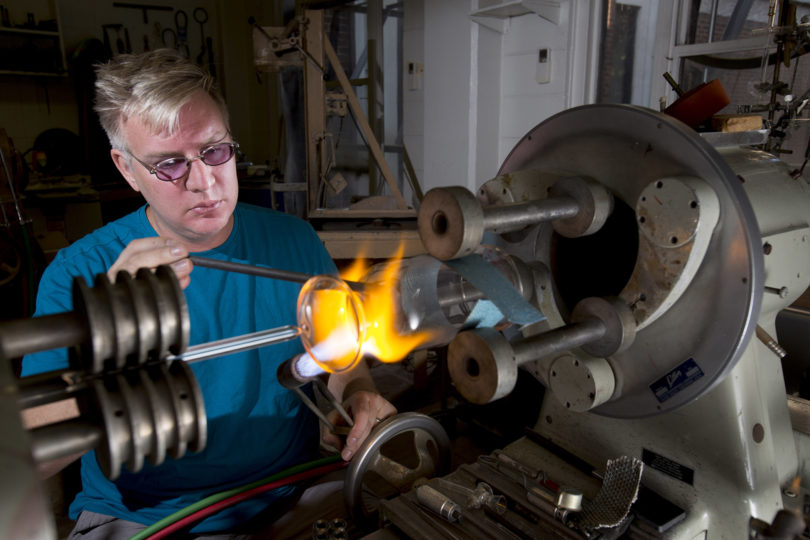FACTS
Kyle Meyer
Glass Shop Manager
- Glass Blowing Shop
- A.A.S., Scientific Glass Technology, Salem Community College, New Jersey, 2003
- At UGA: 2 1/2 months
A chance scholarship to a community college in New Jersey introduced Kyle Meyer to the art of scientific glass blowing more than 13 years ago, and he’s been hooked ever since.
Meyer is the new manager of the UGA Glass Blowing Shop, where he creates and repairs glassware for the university’s science departments. The shop first opened in 1960, but after the last shop manager retired in December 2015, there was a seven-month period when UGA’s scientists headed to the Georgia Institute of Technology for their glass needs. Meyer’s arrival in July helped researchers get the materials they need closer to home.
For 13 years, Meyer worked for Sigma-Aldrich, now part of MilliporeSigma, producing and repairing glass labware. But he’s found the research university environment compelling.
“It’s that one-on-one interaction helping the chemist that’s special to working for a university,” he said. “If you work for a big company, you’re just there making piece after piece and you never get to interact with anybody. Here, it’s fun; you feel like you’re helping out.”
Researchers frequently drop by with designs in mind for future experiments, sometimes bringing Meyer a sketch of what they’re hoping he can bring to fruition. A few weeks ago, he created a mosquito feeder for scientists in the infectious diseases department that used a jacketed piece of glass, which enables researchers to control the temperature of the liquid held inside the device, to attract and feed mosquitoes held in a container below the feeder.
The more complex the job, the better for Meyer, who enjoys challenging himself with complicated projects.
“I like those super intense jobs that take a long time and that you have to be very precise and accurate at every step or the device isn’t going to work,” he said.
There are different types of glass, hard and soft, and selecting the right kind is the key to successful projects. The glass used in scientific research is called hard glass, which is mostly borosilicate- or quartz-based, and it requires a high temperature to melt and become malleable. The torch he uses to fire the glass goes up to 2,000 degrees F, and one of the kilns, or ovens that finishes off fired glassware, tops 1,000 degrees F. More artistic projects, such as the creation of decorative glass bowls or even Coca-Cola bottles, require soft glass, which melts at a lower temperature and stays hot longer, allowing the glass blower more time to manipulate it into the desired form.
Meyer always has been creative, but his art exposure in school left him unfulfilled.
“I’ve always liked to work with my hands and create, but painting and drawing were things I was never really good at or felt I was good at,” he said. “Then when I got into glass blowing, I felt like it fit.”
When he was offered a scholarship to Salem Community College in Carneys Point, New Jersey, he jumped at the opportunity to master a new craft, figuring that the five-year commitment—two years of school, three years of working for Sigma-Aldrich, which sponsored the scholarship—would be bearable even if he found glass blowing tedious.
Prior to attending Salem, the only school in the country to offer a degree in scientific glass technology, Meyer had never heard of glass blowing.
“I just fell into it; it’s kind of crazy,” he said. “I love being a glass blower, but it’s nothing I ever dreamed of.”








